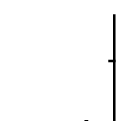- We explore why it is necessary to use the unit tangent vector when we want to consider quantities that depend on changes of direction, not magnitude.
- We explore why arclength is necessary to use as a parameter in order to establish a meaningful definition.
- we explore how to transform the definition to allow us to compute the desired quantity in terms of a given parameterization, thus bypassing the need to find an arclength reparameterization of a curve.
Question: Given a curve, how can we introduce a quantifiable way to measure how quickly it changes direction?
Consider the curve shown below.

This is clearly a pointwise property; the curve changes direction very quickly at, say , compared to at .
In order to introduce a way to measure this, we make the convention that a line should have zero curvature at each point along it. To explore how to quantify a change in direction, do the following.
In the figure above, consider the tangent line to the curve at , , , and .
- What do you notice about the relationship of the tangent lines at and ?
The tangent lines have similar slopes. The tangent have very different slopes.
- What do you notice about the relationship of the tangent lines at and ? The tangent lines have similar slopes. The tangent have very different slopes.
Since we want to work with curves in space, it is necessary to introduce a parameter to describe the curve. We thus choose a parameter and describe the curve in the usual way by the position vector . A vector parallel to the tangent line is thus . In calculus, we like to measure change using derivatives, so can we measure the change by considering the magnitude of how changes. There is an important point to consider though.
Consider the “disguised” line traced out by .
Since this is a line, we want the curvature to be .
Now, we can calculate , so and
and thus
So what is the problem?
While it is true that is a vector in the direction of the tangent line, there are two reasons that it can change:
- The magnitude of can change.
- The direction of can change.
We are not interested in how the magnitude changes; we only are concerned with how the direction changes. To ensure that the magnitude does not change, we instead consider the unit tangent vector . Since the magnitude of a unit vector is always , the only way that the vector can change along the curve is if its direction changes.
Now, consider the line defined by again. We find that , and thus
Thus, and .
Another important consideration is that we want to ensure that small changes in the parameter we choose results in small changes in the location on the curve. We can think of the parameter as a time parameter, and the given parameterization of a curve not only tells us what the curve is, but how quickly it is traced out. If the curve is being traced out very quickly (for example, consider the curve for large values of ) small changes in time may produce large distances travelled. We want to ensure that we are comparing the tangent vector at a given point to a nearby tangent vector.
One way to ensure that small changes in the input parameter do not yield large distances travelled along the curve is to parametrize the curve by arclength. With this in mind, we can now define the “curvature” as a way to quantify how much the curve changes direction.
Let describe a smooth curve parameterized by arclength, and denote the unit tangent vector. Then, the curvature, denoted by , is the magnitude of the rate of change of the unit tangent vector with respect to arclength. That is,
As we noted earlier, parameterizing a curve by arclength is at best computationally annoying, and sometimes can be impossible! Integrating square roots can be troublesome; in fact, there are very few expressions involving radicals for which we can compute antiderivatives. Also, once we find in terms of , we have to solve for in terms of , which also may be impossible (for instance, how would you solve for in terms of ?)
One common theme in multivariable calculus is to use arclength parameterizations to formulate definitions, then use the chain rule to express the results with respect to the original parameter in the problem.
Since the arclength parameter is related to the given parameter by
We can use the Fundamental Theorem of Calculus to write = .
In the original definition, is a function of the arclength parameter , but we can think of as a function of either parameter. Since we are given the parameter , we want to express the curvature in terms of .
Using the chain rule
We just computed in terms of (since , which can be computed from the given parameter without having to find an arclength parameterization), so
Let’s study this in the context of a specific example. Are you ready?
Consider the helix traced out by for .
- Find (i.e. find as a function of ).
To do this, we compute , so , and
- Find .
We find , so
- Calculate using the earlier result.
In general, this quantity might depend on (i.e. the direction might change differently at different points on the curve). Here, we chose a more computationally palatable example to illustrate how to work through the neeccesary calculations.